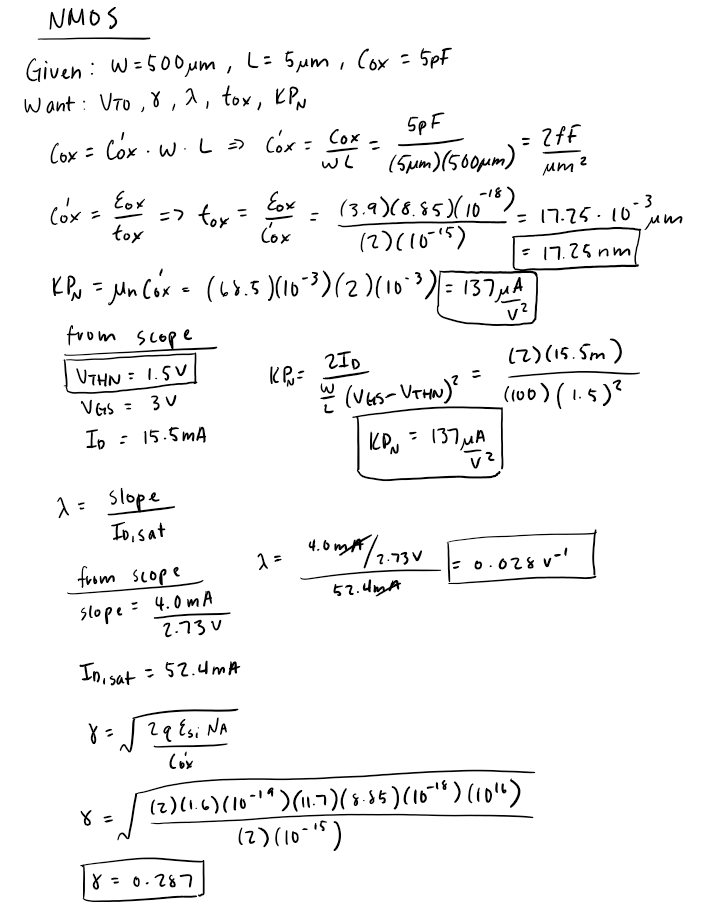Lab 8 - EE 420L
Authored
by Tyler Ferreira,
ferret1@unlv.nevada.edu
April 5, 2017
Pre-lab work
- Review the datasheet for the CD4007.pdf CMOS transistor array.
- Ensure
that you understand how the bodies of the NMOS are tied to pin 7 (VSS,
generally the lowest potential in the circuit, say ground) and that the
bodies of the PMOS are tied to pin 14 (VDD, generally the highest
potential in the circuit, say + 5V).
In
this lab you will characterize the transistors in the CD4007 and
generate SPICE Level=1 models. Assume that the MOSFETs will be used in
the design of circuits powered by a single +5 V power supply. In other
words, don't characterize the devices at higher than +5 V voltages or
lower than ground potential.
- Experimentally generate, for the NMOS device, plots of:
- ID v. VGS (0 < VGS < 3 V) with VDS = 3 V
- ID v. VDS (0 < VDS < 5 V) for VGS varying from 1 to 5 V in 1 V steps, and
- ID v. VGS (0 < VGS < 5 V) with VDS = 5 V for VSB varying from 0 to 3 V in 1 V steps.
- Note
that for this last one, if VSS (NMOS body) is ground (again, the
Body, VB, is grounded) then the source voltage will be varied from 0 to
3 V in 1 V steps to realize VSB ( = VS - VB = VS) varying from 0 to 3 V
in 1 V steps. At the same time VGS will be varied from 0 to 3 V (when
VS = 0), 1 to 4 V (when VS = 1 V), 2 to 5 V (when VS = 2 V), and 3
to 5 V (when VS = 3 V). In other words, as VS is increased by 1 V the
VGS has to shift up by 1 V as well.
- Assuming
that the length of the NMOS is 5 um and its width is 500
um calculate the oxide thickness if Cox (= C'ox*W*L) = 5 pF.
- From this measured data create a Level = 1 MOSFET model with (only) parameters: VTO, GAMMA, KP, LAMBDA, and TOX.
- Compare
the experimentally measured data above (the 3 plots) to
LTspice-generated data (again, 3 plots) and adjust your model
accordingly to get better matching.
- Experimentally,
similar to what is seen on the datasheet (AC test circuits seen on page
3 of the datasheet), measure the delay of an inverter using these
devices (remember the loading of the scope probe is around 15 pF and
there is other stray capacitance, say another 10 pF).
- Using
your model simulate the delay of the inverter and compare to measured
results. Adjust your SPICE model to get better matching between the
experimental data and the measured data.
- Repeat the above steps for the PMOS device where VDS, VGS, and VSB are replaced with VSD, VSG, and VBS respectively.
Experiment 1: Characterization of NMOS device
Handwork:

Important Values:
| VTO | 1.5V |
| GAMMA | 0.287 |
| KPN | 137 uA/V^2 |
| LAMBDA | 0.028 1/V |
| TOX | 17.25 nm |
My Level = 1 MOSFET model:

ID v. VGS (0 < VGS < 3V) with VDS = 3V

| Scope Image | LTspice Sim |
 |  |
ID v. VDS (0 < VDS < 5 V) for VGS varying from 1 to 5 V in 1 V steps

Experimental Results:
| VGS = 1V |  |
| VGS = 2V |  |
| VGS = 3V |  |
| VGS = 4V |  |
| VGS = 5V |  |
LTspice Simulation:

ID v. VGS (0 < VGS < 5 V) with VDS = 5 V for VSB varying from 0 to 3 V in 1 V steps

Experimental Results:
| VSB = 0V |  |
| VSB = 1V |  |
| VSB = 2V |  |
| VSB = 3V |  |
LTspice Simulation:

Experiment 2: Characterization of PMOS device
Handwork:

Important Values:
| VTO | 1.1 V |
| GAMMA | 0.287 |
| KPP | 45.7 u or 53.7 u |
| LAMBDA | 0.089 1/V |
| TOX | 17.25 nm |
My Level = 1 MOSFET model:

ID v. VSG (0 < VSG < 3V) with VSD = 3V

| Scope Image | LTspice Sim |
 |  |
ID v. VSD (0 < VSD < 5 V) for VSG varying from 1 to 5 V in 1 V steps

Experimental Results:
| VSG = 1V |  |
| VSG = 2V |  |
| VSG = 3V |  |
| VSG = 4V |  |
| VSG = 5V |  |
LTspice Simulation:

ID v. VSG (0 < VSG < 5 V) with VSD = 5 V for VBS varying from 0 to 3 V in 1 V steps

Experimental Results:
| VSB = 0V |  |
| VSB = 1V |  |
| VSB = 2V |  |
| VSB = 3V |  |
LTspice Simulation:

Experiment 3: Simulate the delay of the inverter
I will connect my CD4007 chip following the data sheet:

Schematic:

| Scope Image | LTspice Sim |
 |  |
Models used:

I will backup my work on to my OneDrive and my desktop:


Return to the directory listing of my labs
Return to the directory listing of students in EE 420L, Spring 2017
Return to the EE 420L, Spring 2017 webpage






















